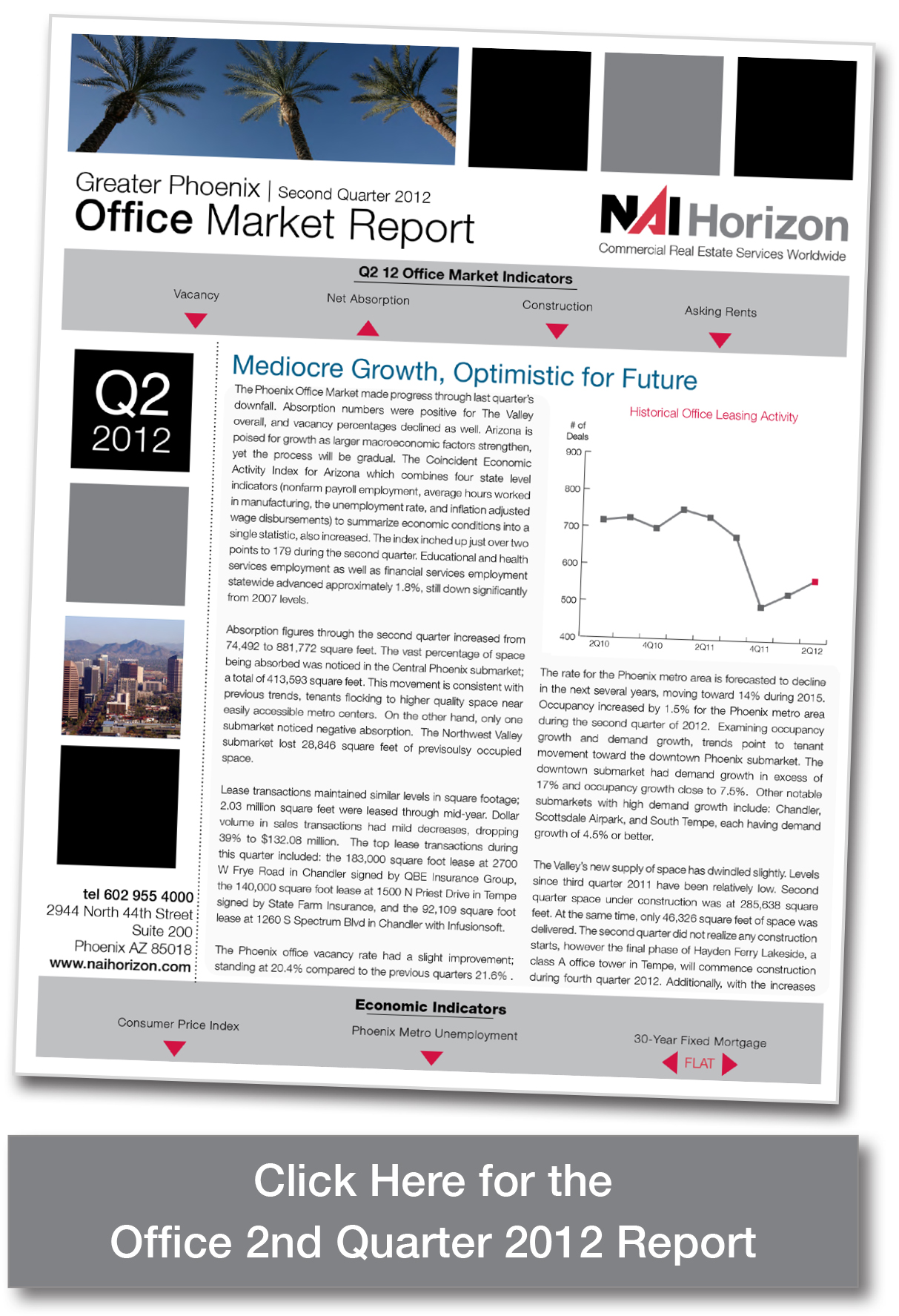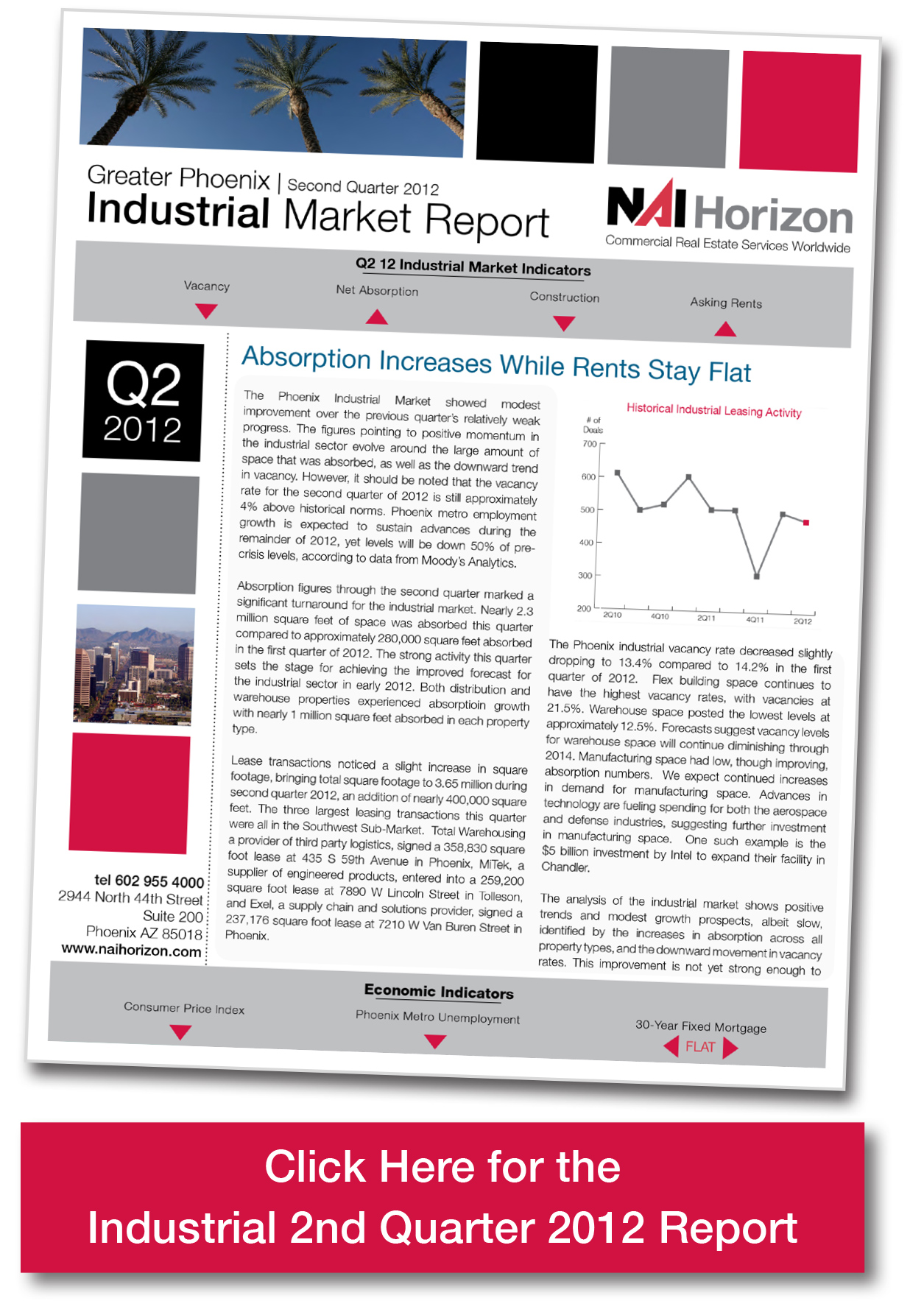The Phoenix Office Market made progress through last quarter’s downfall. Absorption numbers were positive for The Valley overall, and vacancy percentages declined as well. Arizona is poised for growth as larger macroeconomic factors strengthen, yet the process will be gradual. The Coincident Economic Activity Index for Arizona which combines four state level indicators (nonfarm payroll employment, average hours worked in manufacturing, the unemployment rate, and inflation adjusted wage disbursements) to summarize economic conditions into a single statistic, also increased. The index inched up just over two points to 179 during the second quarter. Educational and health services employment as well as financial services employment statewide advanced approximately 1.8%, still down significantly from 2007 levels.
Absorption figures through the second quarter increased from 74,492 to 881,772 square feet. The vast percentage of space being absorbed was noticed in the Central Phoenix submarket; a total of 413,593 square feet. This movement is consistent with previous trends, tenants flocking to higher quality space near easily accessible metro centers. On the other hand, only one submarket noticed negative absorption. The Northwest Valley submarket lost 28,846 square feet of previsoulsy occupied space.
Lease transactions maintained similar levels in square footage; 2.03 million square feet were leased through mid-year. Dollar volume in sales transactions had mild decreases, dropping 39% to $132.08 million. The top lease transactions during this quarter included: the 183,000 square foot lease at 2700 W Frye Road in Chandler signed by QBE Insurance Group, the 140,000 square foot lease at 1500 N Priest Drive in Tempe signed by State Farm Insurance, and the 92,109 square foot lease at 1260 S Spectrum Blvd in Chandler with Infusionsoft.
The Phoenix office vacancy rate had a slight improvement; standing at 20.4% compared to the previous quarters 21.6% . The rate for the Phoenix metro area is forecasted to decline in the next several years, moving toward 14% during 2015. Occupancy increased by 1.5% for the Phoenix metro area during the second quarter of 2012. Examining occupancy growth and demand growth, trends point to tenant movement toward the downtown Phoenix submarket. The downtown submarket had demand growth in excess of 17% and occupancy growth close to 7.5%. Other notable submarkets with high demand growth include: Chandler, Scottsdale Airpark, and South Tempe, each having demand growth of 4.5% or better.
The Valley’s new supply of space has dwindled slightly. Levels since third quarter 2011 have been relatively low. Second quarter space under construction was at 285,638 square feet. At the same time, only 46,326 square feet of space was delivered. The second quarter did not realize any construction starts, however the final phase of Hayden Ferry Lakeside, a class A office tower in Tempe, will commence construction during fourth quarter 2012. Additionally, with the increases in construction employment, and strengthening in capital lending, there should be an increase in construction activity in the years to come.
There has a been a mass transition away from class C properties into higher quality class A & B properties. Although the move to higher quality office properties has commanded nearly a 23% rent premium over lower quality properties, rental rates altogether have stayed relatively stagnant. Most CRE assets are being reevaluated and priced accordingly, discounted because of the tremendous outstanding debt. This suggests tenants are finding great deals on new space leases, as well as sale properties. Rental rates across all property classes slid down .9% to an average of $19.93 this quarter. This theme is consistent with other sectors of the CRE industry; tenants are still maintaining the pricing power, and landlords are typically keeping rents steady to sustain tenant retention numbers.
The markets most prone to space absorption and rental growth will be technology, energy, and health care. Phoenix serves several large scale defense and aerospace companies. With easy access for further investment, Arizona is positioned to become an attractive marketplace for several high-tech sector companies. Arizona’s EnviroMisson Solar Tower and Arizona’s Solar Strategic Plan by The Arizona Energy Consortium outline initiatives that will contribute to the value of the tech sector in Arizona.
Cap rates trended down this quarter for Arizona’s office market, rates subsided to 6.61% from 7.91%. Nationally capitalization rates for the office sector averaged 7.20% during the first quarter. Across the nation rental rates for office space have increased 1.6% on year-over-year basis to $28.10. At the same, the vacancy rate fell 40 basis points to 17.2%; the historical vacancy low is 12.5%. The addition of only 100,000 to 150,000 workers per month equals out to a slow and sluggish recovery, not the fast paced regaining the US would like. Expect the remainder of 2012 to exhibit positive albeit slow growth for the office market.


